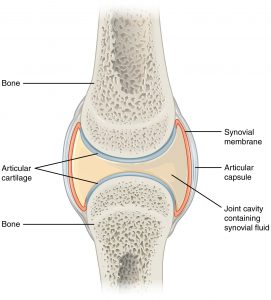41 Friction in Joints
Synovial Joint Friction
Static and kinetic friction are both present in joints. Static friction must be overcome, by either muscle tension or gravity, in order to move. Once moving, kinetic friction acts to oppose motion, cause wear on joint surfaces, generate thermal energy, and make the body less efficient. (We will examine the efficiency of the body later in this textbook.) The body uses various methods to decrease friction in joints, including synovial fluid, which serves as a lubricant to decrease the friction coefficient between bone surfaces in synovial joints (the majority of joints in the body). Bone surfaces in synovial joints are also covered with a layer of articular cartilage which acts with the synovial fluid to reduce friction and provides something other than the bone surface to wear away over time[1]. We ignored friction when analyzing our forearm as a lever because the frictional forces are relatively small and because they acted inside the joint, very close to the pivot point so they caused negligible torque.

Reinforcement Exercises
Find a value for the kinetic coefficient of friction between ends of a bone in a synovial joint lubricated by synovial fluid. State your value and your source.
If the normal force between bones in the knee is 160 lbs, what is the kinetic frictional force between the surfaces of the knee bones?
- OpenStax, Anatomy & Physiology. OpenStax CNX. Jun 25, 2018 http://cnx.org/contents/14fb4ad7-39a1-4eee-ab6e-3ef2482e3e22@10.1. ↵
a force that resists the tenancy of surfaces to slide across one another due to a force(s) being applied to one or both of the surfaces
the force that is provided by an object in response to being pulled tight by forces acting from opposite ends, typically in reference to a rope, cable or wire
attraction between two objects due to their mass as described by Newton's Universal Law of Gravitation
a force that resists the sliding motion between two surfaces
energy stored in the microscopic motion of atoms and molecules (microscopic kinetic energy)
ratio of useful work performed to total energy expended
coefficient describing the combined roughness of two surfaces and serving as the proportionality constant between friction force and normal force
small enough as to not push the results of an analysis outside the desired level of accuracy
the outward force supplied by an object in response to being compressed from opposite directions, typically in reference to solid objects.

